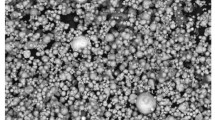Abstract
A defect-free, two-material component can be obtained via co-sintering by suitably altering the powder characteristics or compositions, as demonstrated in Part I. In this paper, a model to ascertain the suitability of material systems to be co-sintered without defects such as delamination or interface pores is presented. The model is based on the management of the stress induced due to the difference in shrinkage and an analysis of the in situ strength of the weaker material during sintering. Tool steel in combination with stainless steel admixed with boron and Fe-2Ni admixed with boron are two systems used to validate the model. The predictions of the model are in good agreement with the observations.
Similar content being viewed by others
References
C. A. Brush Amer. Ceram. Soc. Bulletin 41 (1962) 799.
F. F. Lange and M. Metcalf J. Amer. Ceram. Soc. 66 (1983) 398.
P. Z. Cai D. J. Green and G. L. Messing, ibid. 80 (1997) 1929.
D. F. Heaney P. Suri and R. M. German, Part I, Submitted to the Same Journal.
A. Zavaliangos and Y. Li, in “Advances in Powder Metallurgy and Particulate Materials,” edited by J. J. Oakes and J. H. Reinshagen (Metal Powder Industries Federation, Princeton, NJ, 1998) Vol. 2, p. 7.
P. Z. Cai D. J. Green and G. L. Messing J. Amer. Ceram. Soc. 80 (1997) 1940.
R. K. Bordia and A. Jagota, ibid. 76 (1993) 2475.
T. Cheng and R. Raj, ibid. 72 (1989) 1649.
K. Shinagawa, in Proceedings of the 4th International Symposium on Functionally Graded Materials, edited by I. Shiota and Y. Miyamoto, Tsukuba, Japan, 1996, p. 69.
A. Maximenko O. van der Biest and E. Olevsky Inter. J. Fract. 110 (2001) L9.
H. Riedel and T. Kraft, Materials Science Forum, Vol. 308–311, 1999, in Proceedings of the 5th International Symposium on Functionally Graded Materials, edited by W. A. Kaysser, Dresden, Germany, 1998, p. 1035.
A. Jagota and C. Y. Hui Mech. Mater. 11 (1991) 221.
J. Kanters U. Eisele and J. Rodel J. Amer. Ceram. Soc. 84 (2001) 2757.
R. M. German, in “Sintering Theory and Practice” (Wiley Interscience Publication, John Wiley and Sons, New York, NY, 1996) p. 76.
X. Xu P. Lu and R. M. German J. Mater. Sci. 37 (2002) 117.
R. Haynes Rev. Def. Behav. Mater. 3 (1981) 1.
H. Danniger G. Jangg B. Weiss and R. Stickler Powder Met. Intl. 25 (1993) 111.
E. Navara and B. Bengtsson Intl. J. Powder Met. Powder Tech. 20 (1984) 33.
M. Haghi and L. Anand Mech. Mater. 13 (1992) 37.
C. Geindreau D. Bouvard and P. Doremus Euro. J. Mech. Solids 18 (1999) 597.
M. B. Rubin O. Y. Vorobieu and L. A. Glen Intl. J. Solids Struct. 37 (2000) 1841.
B. Wang J. R. Klepaczko G. Lu and L. X. Kong J. Mater. Proc. Tech. 113 (2001) 574.
R. Raj and R. K. Bordia Acta Metall. 32 (1984) 1003.
M. Gasik and B. Zhang Comp. Mater. Sci. 18 (2000) 93.
U. Lindstedt B. Karlson and R. Masini Intl. J. Powder Met. 33 (1997) 49.
E. S. Palma J. Brazilian Soc. Mechan. Sci. 29 (1997) 72.
N. E. Dowling, in “Mechanical Behavior of Materials: Engineering Methods for Deformation, Fracture and Fatigue,” 2nd ed, (Prentice Hall, New Jersey, 1998) p. 565.
L. Bertini V. Fontanari and G. Straffelini Trans. Amer. Soc. Mechan. Eng. 120 (1998) 248.
G. A. Shoales and R. M. German Met. Mater. Trans. 29A (1998) 1257.
A. Pest F. Petzoldt H. Eifert G. Veltl and T. Hartwig, in “Advances in Powder Metallurgy and Particulate Materials,” edited by T. M. Cadle and K. S. Narasimhan (Metal Powder Industries Federation, Princeton, NJ, 1996) Vol. 5, p. 19.171.
P. Z. Cai G. L. Mesing and D. L. Green J. Amer. Ceram. Soc. 80 (1997) 445.
U. Lindstedt and B. Karlsson, Doktorsavhandlingar vid Chalmers Tekniska Hogskola (1998) Vol. 1375, p. 1.
S. Lou and D. O. Northwood J. Mater. Eng. Per. 33 (1994) 344.
N. S. Mishra S. Mishra and V. Ramaswamy Met. Trans. 20A (1989) 2819.
“Engineering Properties of Steel,” edited by P. D. Harvey (American Society of Metals, Metals Park, OH, 1982).
G. Lu G. Q. Lu and Z. M. Xiao J. Porous Mater. 6 (1999) 359.
W. D. Pilkey, in “Peterson's Stress Concentration Factors,” 2nd ed. (John Wiley & Sons, New York, NY, 1997).
Author information
Authors and Affiliations
Rights and permissions
About this article
Cite this article
Suri, P., Heaney, D.F. & German, R.M. Defect-free sintering of two material powder injection molded components Part II Model . Journal of Materials Science 38, 4875–4881 (2003). https://doi.org/10.1023/B:JMSC.0000004408.44675.f6
Issue Date:
DOI: https://doi.org/10.1023/B:JMSC.0000004408.44675.f6




